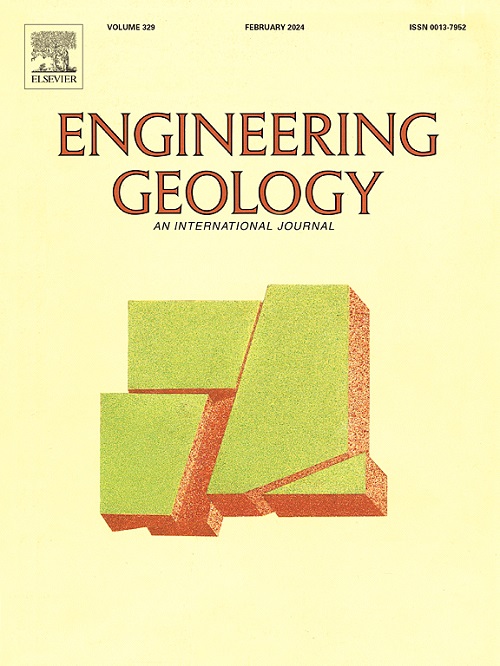3D high-density ambient noise imaging of the Nankou-Sunhe buried active fault in Beijing
IF 8.4
1区 工程技术
Q1 ENGINEERING, GEOLOGICAL
引用次数: 0
Abstract
The Nankou-Sunhe fault (NSF) is a vital buried active fault within the Beijing Plain. Investigating the detailed structure of the NSF and the sedimentary structures on both sides is pivotal for urban engineering projects to mitigate geological hazards. Three-dimensional (3D) seismic exploration can provide comprehensive and precise information about subsurface structures, aiding in the identification and characterisation of the spatial geometry, extensional direction, and features of sedimentary structures on both sides of the fault. In this study, we conducted a 3D high-density ambient noise seismic survey covering approximately 40 km2 around the NSF. Utilising the Multichannel Analysis of Passive Surface waves (MAPS), we obtained fundamental mode Rayleigh wave phase velocity diagrams in the 0.5–4 Hz range, subsequently inverting them to reveal a 3D shear (S)-wave velocity model extending to a depth of 1 km. The model shows lower velocities in the southwestern region, with shallow S-wave velocities of approximately 400–600 m/s and deep-seated velocities ranging from 1800 to 2000 m/s. The northeastern region is characterised by higher velocities, with shallow S-wave velocities of approximately 900–1200 m/s and deeper velocities reaching 3000–3400 m/s. The NSF is a high angle (50°-70°) normal fault striking northeast and dipping towards the southwest; the dip angle exhibits local variation. An S-wave velocity of 1 km/s was used to estimate sediment thickness on both sides of the fault. The MaChikou Sag (MCKS) on the southwest side of the NSF is approximately 400–600 m thick, while the northeastern JingXi High (JXH) is less than 200 m thick. The NSF was positively correlated with the bedrock surface (1 km/s isovelocity). Moreover, this study ascertained that by employing MAPS with a 200 m station spacing within a complex and noisy urban environment, one can extract accurate fundamental-mode Rayleigh waves, allowing for the subsequent construction of a 3D high-resolution S-wave velocity model.
北京南口-孙河隐伏活动断裂三维高密度环境噪声成像
南口-孙河断裂是北京平原内一条重要的隐伏活动断裂。研究NSF的详细构造及其两侧的沉积构造是城市工程项目减轻地质灾害的关键。三维地震勘探可以提供全面而精确的地下构造信息,有助于识别和表征断层两侧的空间几何形状、伸展方向和沉积构造特征。在这项研究中,我们对NSF周围约40 km2的区域进行了三维高密度环境噪声地震调查。利用被动表面波多通道分析(MAPS),我们获得了0.5-4 Hz范围内的基本模态瑞利波相速度图,随后将其反演,得到了延伸至1 km深度的三维剪切(S)波速度模型。模型显示西南地区速度较低,浅层横波速度约为400 ~ 600 m/s,深层横波速度约为1800 ~ 2000 m/s。东北地区速度较大,浅层横波速度约为900 - 1200m /s,深层横波速度约为3000 - 3400m /s。NSF为一条高角度(50°~ 70°)正断层,走向东北,向西南倾斜;倾角呈现局部变化。采用1 km/s的横波速度估算断层两侧的沉积物厚度。NSF西南侧的马池口凹陷(MCKS)厚度约为400 ~ 600 m,而东北侧的靖西高压(JXH)厚度不足200 m。NSF与基岩面(1 km/s等速度)呈正相关。此外,本研究确定,在复杂和嘈杂的城市环境中,使用200 m站距的MAPS可以提取准确的基模瑞利波,从而允许随后构建3D高分辨率横波速度模型。
本文章由计算机程序翻译,如有差异,请以英文原文为准。
求助全文
约1分钟内获得全文
求助全文
来源期刊

Engineering Geology
地学-地球科学综合
CiteScore
13.70
自引率
12.20%
发文量
327
审稿时长
5.6 months
期刊介绍:
Engineering Geology, an international interdisciplinary journal, serves as a bridge between earth sciences and engineering, focusing on geological and geotechnical engineering. It welcomes studies with relevance to engineering, environmental concerns, and safety, catering to engineering geologists with backgrounds in geology or civil/mining engineering. Topics include applied geomorphology, structural geology, geophysics, geochemistry, environmental geology, hydrogeology, land use planning, natural hazards, remote sensing, soil and rock mechanics, and applied geotechnical engineering. The journal provides a platform for research at the intersection of geology and engineering disciplines.
 求助内容:
求助内容: 应助结果提醒方式:
应助结果提醒方式:


